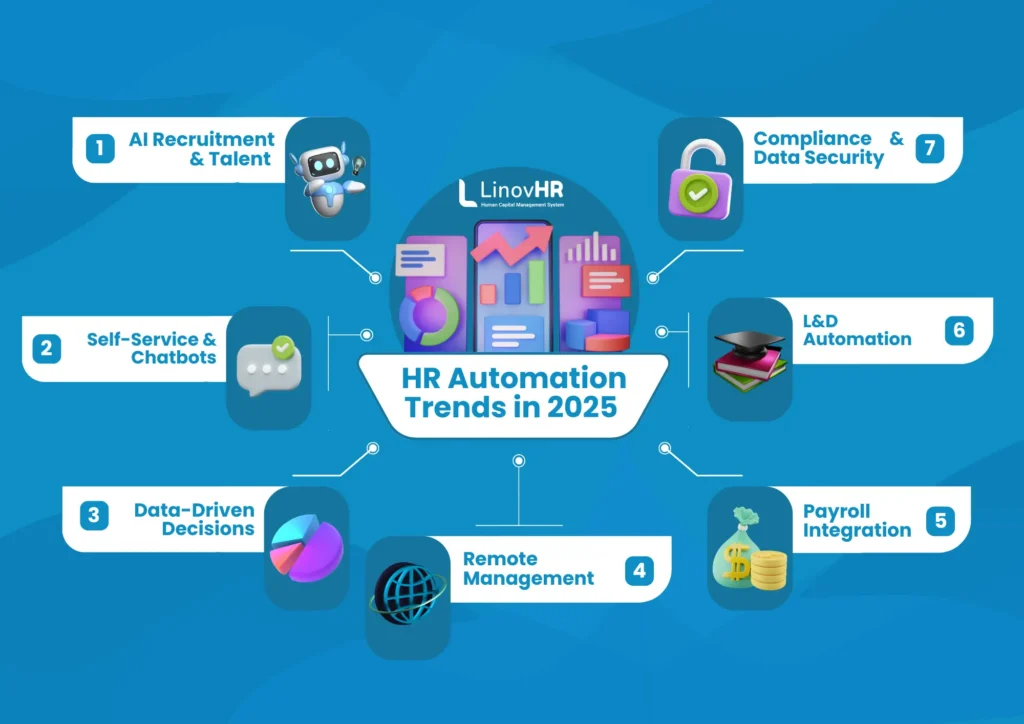As businesses continue to navigate the ever-changing world of work, automation has become one of the most significant forces shaping the future of HR.
In Indonesia, HR automation trends are gaining rapid momentum as companies strive to improve efficiency, compliance, and employee engagement in an increasingly digital economy.
With the government supporting digital transformation and the adoption of HR technology in both private and public sectors, businesses are turning to automation tools to handle complex processes such as payroll, attendance tracking, and workforce analytics.
In this article, we will explore the key trends in HR automation that are transforming how companies manage their workforce. You’ll discover how HR technology is improving efficiency, uncovering new insights, and creating a more adaptive and data-driven HR landscape.
What Is HR Automation?
HR automation refers to the use of technology such as software, artificial intelligence (AI), and digital tools to perform repetitive and administrative HR tasks with minimal human intervention.
These tasks include managing attendance, processing payroll, onboarding new employees, and handling employee data. By automating these processes, HR departments can operate more efficiently while reducing the risk of human error.
In today’s digital workplace, trends in HR automation have evolved from simple data management into a comprehensive system that supports decision-making and strategic planning. Modern HR automation systems are designed to collect, analyze, and interpret employee information in real time.
This enables HR professionals to make data-driven decisions, improve workforce planning, and identify areas where the employee experience can be enhanced.
Emerging HR Automation Trends in 2025

Below are some of the most impactful HR automation trends 2025 that every HR professional should keep an eye on.
1. AI-Powered Recruitment and Talent Matching
Artificial intelligence continues to revolutionize talent acquisition. In 2025, more companies are integrating AI tools into their HR automation systems to streamline candidate screening, evaluate resumes, and even predict cultural fit.
AI algorithms can analyze vast amounts of candidate data within seconds, significantly reducing hiring time and improving the quality of hires. Moreover, predictive analytics helps recruiters make smarter decisions by identifying which candidates are most likely to succeed in specific roles.
2. Employee Self-Service and Chatbots
These tools empower employees to handle routine HR tasks independently such as updating personal data, checking leave balances, or requesting attendance corrections without HR intervention.
Chatbots enhance accessibility by providing real-time responses to HR-related questions, available 24/7. This automation not only saves time but also boosts employee satisfaction by delivering faster and more consistent support.
3. Data-Driven HR Decision Making
As HR data becomes a company’s strategic asset, analytics is at the core of HR automation trends. In 2025, advanced analytics platforms enable HR teams to turn workforce data into actionable insights.
Predictive analytics can forecast employee turnover, measure engagement levels, and assess productivity trends. Companies that leverage these tools gain a competitive advantage by making proactive, evidence-based decisions rather than reactive ones.
4. Remote and Hybrid Workforce Management
With hybrid work now a permanent model in many companies, HR automation systems are evolving to manage distributed teams efficiently. Modern HR platforms integrate attendance tracking, productivity analytics, and performance monitoring into one dashboard.
These systems ensure transparency and accountability, regardless of employee location. Moreover, automation tools help HR maintain compliance with labor regulations across regions while ensuring a seamless employee experience.
5. Integration with Payroll and Finance
The convergence of HR and finance functions is another defining trend in HR automation trends 2025. Integrated systems allow for synchronized data flow between HR operations including attendance, overtime, or bonuses and payroll processing.
This eliminates manual data transfers, reduces errors, and ensures timely salary disbursements. Such integrations also enable CFOs and HR to align workforce costs with business objectives more accurately.
6. Learning and Development Automation
Continuous learning is now essential in a rapidly changing work environment. In 2025, HR automation tools are transforming learning management systems (LMS) into intelligent platforms, delivering personalized learning paths based on individual performance and career goals.
Automation ensures training programs are automatically assigned, progress is tracked in real-time, and managers receive insights into team skill gaps. This not only enhances upskilling initiatives but also strengthens employee retention and engagement.
7. Compliance Automation and Data Security
In response to evolving labor laws and data protection regulations, compliance automation has become a top priority. HR automation systems now include built-in compliance management features that update automatically when new policies or tax rules are introduced.
Additionally, with sensitive employee data stored digitally, advanced encryption and role-based access are crucial to ensure security and privacy. This helps companies maintain trust and minimize risks of legal or reputational damage.
Benefits of Adopting HR Automation Trends
Below are the main benefits that highlight why HR automation trends have become an essential part of modern workforce management.
1. Enhanced Efficiency and Time Savings
Automation eliminates repetitive manual tasks such as attendance tracking, payroll processing, or leave approvals.
This allows HR professionals to focus on more strategic areas like employee experience and company development. As a result, companies can achieve faster workflows and higher productivity without increasing headcount.
2. Improved Accuracy and Compliance
Manual HR processes are prone to human error, which can lead to payroll miscalculations or policy violations.
Automated systems ensure data consistency and regulatory compliance through real-time updates and integrated audit trails. This minimizes risks while ensuring companies meet legal standards across different regions.
3. Data-Driven Insights for Better Decision Making
One of the biggest advantages of trends in HR automation is the ability to collect and analyze real-time workforce data. Automated analytics tools provide insights into turnover rates, performance metrics, and employee engagement trends.
These insights empower HR leaders to make data-driven decisions that align with long-term business goals.
4. Greater Employee Engagement and Experience
Modern HR automation trends 2025 prioritize user-friendly employee self-service portals. These systems give employees more control over their HR related needs, such as accessing payslips or applying for leave.
This sense of empowerment improves satisfaction, fosters transparency, and strengthens trust between HR teams and employees.
5. Cost Efficiency and Scalability
Automating HR processes helps your company reduce administrative costs by minimizing manual workloads and paperwork.
Additionally, HR automation systems are scalable meaning they can grow alongside business expansion. Whether managing 50 or 5,000 employees, automation ensures consistent performance and data integrity.
Common Challenges in HR Automation
Understanding these challenges helps HR prepare and strategize for a more successful digital transformation. One of the most common obstacles is employee resistance to change. Automation often raises concerns about job security or unfamiliar technology among HR teams and staff members.
Without proper training or communication, employees may struggle to adapt, leading to underutilization of new tools. To address this, companies must emphasize how automation supports not to replace human roles and provide hands on training to ensure smooth adoption.
Another major challenge lies in data integration and system compatibility, many companies still rely on legacy systems or fragmented HR tools that don’t communicate effectively with one another.
This can cause data silos, reporting inconsistencies, and operational inefficiencies. To overcome this, companies should select a unified HR automation platform capable of centralizing all HR data including covering recruitment, attendance, payroll, and performance in one secure ecosystem.
Lastly, data privacy and compliance risks continue to grow as more employee information moves online.
With regulations like Indonesia’s Personal Data Protection Law or PDP Law and the GDPR internationally, businesses must ensure that their HR automation systems have strong security measures and compliance capabilities.
How to Implement HR Automation Trends Effectively
As an HR, you must ensure that every automation initiative contributes to productivity, compliance, and employee engagement. Here’s how businesses can implement HR automation trends 2025 successfully.
1. Define Clear Objectives and Key Metrics
Before adopting any HR automation system, companies should establish well-defined objectives. These goals might include reducing manual administrative work, improving employee experience, or gaining better insights from HR analytics.
Having measurable KPI’s such as reduced payroll processing time or improved recruitment efficiency helps evaluate success and ROI.
By focusing on outcomes, HR teams can ensure that automation aligns with the company’s overall strategy rather than functioning as a standalone project.
2. Choose the Right Technology Partner
Businesses should look for vendors offering scalable and customizable HR automation systems that integrate with existing workflows like payroll, performance management, and attendance tracking.
Local providers such as LinovHR, for instance, understand Indonesian business needs and offer compliance-ready solutions to help companies navigate regulations and workforce complexities. Prioritize solutions that combine automation, analytics, and employee self-service in one unified platform.
3. Invest in Employee Training and Change Management
Even the most advanced HR automation software can fail without proper training and change management. Employees need to understand how automation will make their tasks easier, not replace them.
Also read: 12 HR Automation Tools: Transforming HR Operations with Technology
Conduct workshops, onboarding sessions, and continuous learning programs to build confidence and digital literacy across HR and management teams. A culture that embraces innovation ensures smoother transitions and higher adoption rates.
4. Start Small and Scale Gradually
Rather than automating every HR process at once, start with high-impact areas such as recruitment or attendance management. Evaluate results, gather feedback, and refine processes before expanding automation to other HR functions.
This phased approach allows for continuous improvement and minimizes operational disruption. As businesses grow, scalable HR automation trends enable your company to adapt and expand their automation roadmap efficiently.
5. Monitor, Evaluate, and Continuously Improve
Effective trends in HR automation require ongoing evaluation. HR leaders should track performance metrics, user satisfaction, and system reliability to identify areas for optimization.
Regular audits and employee feedback loops help ensure the automation strategy remains aligned with changing business priorities. With continuous improvement, companies can sustain long-term efficiency and innovation through automation.
Drive Efficiency and Growth Through HR Automation with LinovHR
As businesses continue to evolve in 2025, adopting the latest HR automation trends is no longer optional, it’s essential for staying competitive and ready for the future.
Automation enables HR teams to move beyond manual administrative work and focus on what truly matters. Including developing talent, improving employee experience, and driving business growth.
To fully leverage these trends in HR automation, businesses need a trusted technology partner that understands both global HR innovations and local compliance challenges. With LinovHR’s HRIS software is designed to streamline every HR process.
From employee data management to career development and performance evaluation. By combining innovation, LinovHR empowers HR to implement automation strategies that align with your company goals.
Request a free demo now! Stay ahead of the curve in HR automation trends with LinovHR.






